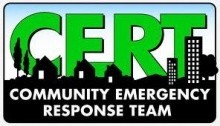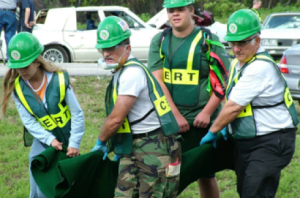Last month I promised to describe the contents of a well prepared grab and go kit. Grab and go is just that. The kit is designed to get you by for a few days until help has arrived. Lets start
with the bag you are going to put your stuff in. A sturdy medium sized backpack or a canvas style bag with large straps will work nicely. You need to assume that you will be out of your home for a
short while. That means you will need a few clothes that match the weather. In the fall, winter, you will need a jacket, jeans, cotton socks, shirt, hat, sturdy shoes, leather work gloves, and a rain
poncho. In the summer, your bag will be lighter but stay with long pants. Buy a small first aid kit to deal with any injuries you might sustain during the emergency. Figure on spending at least
$25.00 on a well prepared First Aid Kit in a fabric bag ..Don't scrimp here.
Food for a few days is good to have also. Power bars are handy and easy to store.
Crackers and peanut butter packs provide good energy. Bottled water is important but heavy. There is a product called Lifestraw that solves the weight issue and is easy to carry. The Lifestraw is 99%
effective in filtering questionable water sources. They have an unlimited shelf life and filter 1000 gallons of water. This is really a great product. You should add a flashlight and batteries to
your kit also. Don't forget, you may be in your car when disaster strikes so think about a kit for your car also. One other thing that would make your life a bit more comfortable would be a
lightweight pop up tent and a sleeping bag for sheltering in place. The tent and sleeping bag can be placed in an outdoor storage shed or near an exit door. I've given you a bunch of stuff to put in
your bag. Don't let it get so heavy that yo
u can't lift it. You can always put some items in a storage container with a tight lid outside on your patio. Sources: amazon.com
Simpler Life (909) 798-8108 (800) 266-7737...
SOS Survival Products, sosproducts.com (800) 479-7998
Thank you, Steve McGill
_____________________________________________________________
We occasionally give you suggestions and lists of items that help you prepare for an emergency. In that spirit, if a disaster happened in the next hour, would you be able to grab what you need and leave your home? The answer is probably not. Here are a few things that you'll need to think about taking along. First of all, what you are leaving with needs to be in some sort of a container. A large cloth type bag with handles or a plastic container with handles so that you can easily grab and go! You'll need to place it in an area where it is easy to get to on your way out. A closet near your front door is usually a good choice.
Some of the important things in your grab and go container might be: 1. Cash in smaller denominations 2. eye glasses and sun glasses 3. cell phone and phone numbers 4. drinking water 5. flashlight and fresh batteries
6. nutrition bars, trail mix 7. toilet paper 8. pre-moistened towelettes 9. sunscreen 10. a separate sealable plastic bag with your personal documents and your medications 11. a small first aid kit
12. Try to wear or grab clothes and shoes that are compatible with the weather, possibly in another cloth bag.
These are just a few of the items for your grab and go bag. Other personal and medical items may be necessary to get you through a few days. Please think about you and your family's safety.
Get prepared!
._____________________________________________________________________
This month, I want to talk to you a bit about fire extinguishers. Fire extinguishers obviously are designed to put out fires. They are labeled A,B,C,D,and K. The agents that are in the extinguishers can be dry powders, CO2 gas, special agents, and chemicals. The type of fire extinguisher you buy for your home should reflect the area of your home you keep it in. Most extinguishers labeled Class A do well in the main living areas of your home where solid materials might burn (furniture, plastics, and curtains.) Class B is better on flammable liquid fires and would be a good choice for the garage. Class C is for electrical fires. Class D is good for combustible metals, and class K is for kitchen grease fires. For a normal household class A,B, and K would be good choices. Prices vary by size and content. The inexpensive ones cannot be recharged. Always try to get one with a gauge on it so that you can see if it is loosing pressure. If you buy an extinguisher that can be recharged, they will be a bit more expensive. The good part is that you can recharge and reuse it instead of throwing it away. While we are talking about fire safety, keep the batteries in your smoke detectors fresh.
.
>>>>>>>>>>>>>>>>>>>>>>>>>>>>>>>>>>>>>>>>>>>>>>>>>>>>>>>>>>>>>>>>>>>>>>>>>>>>>>>>>>>>>>>>>>>>>>>>>>>>>
I'm always harping at you to be prepared and hopefully, if I've done my job right, some of you actually do get prepared.
It's always gratifying to see folks putting away water and emergency food. The biggest part of emergency preparedness is that you take it seriously. As we have seen with the disasters in Houston and Florida, peoples lives are devastated and recovery time tends to be long and laborious. The more you prepare, the better the outcome will be for you and your family.
There are long lists of products and equipment that are designed to keep you safe and comfortable. If we are forced out of our homes due to an emergency, something simple like a pop up style tent with sleeping bags will keep you out of the weather and semi comfortable for a time. In their bags, they don't take up much room. Remember to store them in a place that is easy to grab and run.
If you store stuff outside, consider placing things in a trash bag inside trash cans with tight lids. Don't forget your water, 1 gallon a day per person. Try to store your stuff out of the sun if possible. I'm including some recommended resources for supplies.
Our new Harbor Freight, is a good source for emergency
tools.
Simpler Life Survival Products in Redlands for emergency supplies of all kinds:2035 Park Ave.
Redlands (909) 798-8108
S.O.S. survival products 15705 Strathern St. Van Nuys (800) 479-7998.
You can find all these stores online. I hope you'll use these resources to insure your safety
Don't forget to keep those radio and flashlight batteries charged.
Steve McGill SDV CERT coordinator (951) 849-7678
As an introduction to the “Training Page," we all need to re-study sections of our CERT Training Manual in order to stay aware of the subjects we covered while in class. "The Training Page" will do that job in small easy to remember sections.
If you are not yet a CERT Member, please consider taking the 3 day course offered free to all residents of Riverside County. I will keep you posted on upcoming classes and refreshers. Refresher courses are offered each year and are certainly the best choice for re-training.
If you are a Volunteer and want to serve in that capacity, please feel free to go over the training page and absorb the information. The training pages I send you are right out of the CERT Manual. I will try to use short versions of the material to keep reading at a minimum. If you want to go through the entire manual, there is a great copy of the CERT Manual in our library along with our SDV CERT Operations Guide that describes how we operate during emergencies. If you have questions about the material, I will get you an answer, so feel free to ask questions. If you have suggestions, we are interactive and I am open to all suggestions. Please spread the word to neighbors about our program and ask if they would like to be on our mailing list. Your help is important. We have an excellent CERT Team including our Emergency Volunteers here at SDV, so let’s do a little study to stay Sharp.
Steve (951) 849-7678
Below is the first issue of The Training Page:
This is the 9/12/2013 Disaster Communications Inter-Community Frequency chart - it is hard to read on this page but it can be printed or downloaded from this site in a readable format.










